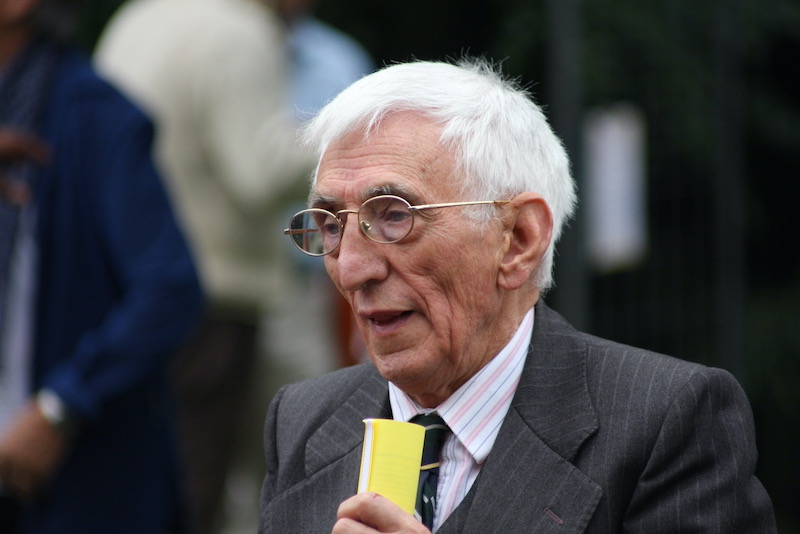Giorgio Tourn
Giorgio Tourn died at his home in Rorà during the night of October 5th – 6th. Although for decades he had an outsized role in Italian Waldensian life, more than anything else Giorgio Tourn was a pastor. He was 95 years old at his passing. The following tribute was written by Alberto Corsani.
It’s difficult, upon learning of Giorgio Tourn’s death, not to think of his latest book, My Emmaus: Story of a Waldensian Pastor. Autobiographical in structure, it’s much more an account of Giorgio´s relationship with God.
Born in Rorà in 1930, he spent his childhood in Turin and then, after the beginning of World War II, in France. Starting in 1949, he studied at the Waldensian Faculty of Theology before moving to Basel, Switzerland, to hear lectures by the great theologians Karl Barth and Oscar Cullmann. In 1955, after completing what Americans would call an intern year in Milan and writing a thesis on “The Ecclesiological Meaning of the Expression Soma Cristou (Body of Christ) in the Letters of Paul,” Giorgio was ordained and sent to Massello, in the Germanasca Valley near Turin. During much of the 13 years he was pastor in Massello, he helped at the Agape Center, where he organized and led camps and for two years served as vice-director. During his time in Massello, he also enrolled in the Faculty of Letters and Philosophy in Turin, where he studied under the Italian existentialist philosopher Nicola Abbagnano. In 1969, Giorgio moved to Pinerolo, where he served until 1977, when he moved to Torre Pellice. He remained pastor in Torre Pellice until 1989, the 300th anniversary of the Glorious Return, when he became the first director of the newly formed Waldensian Cultural Center.
Giorgio was also a writer. He was both a writer and editor for Riforma – L’Eco delle valli valdesi. He also wrote for Protestantesimo, the magazine of the Waldensian Faculty of Theology,and Diakonia.
Giorgio also wrote many books for the Claudiana publishing house, ranging from his narrative history of the Waldensians (I valdesi. La singolare storia di un popolo chiesa) which enjoyed many reprintings, making it not only a best-seller but also a long-seller) to portraits of Bonhoeffer, Calvin, and Olivetan.) He also edited commentaries on such Reformation texts as the Augsburg Confession of 1530 and the complete Italian edition of Calvin’s Institutes of the Christian Religion.
Giorgio Tourn always amazed people with his books. After publishing a personal “sociological” investigation titled “A Church in Analysis. The Waldensians Facing Tomorrow” (a text I was rightly asked to study as a teenager before I became a church member), several times he declined to update it, saying it wasn’t possible because everything was changing too fast. But he did return to some of the themes of that book in a novel (Salvare Cesarina,) a form that seemed most appropriate. In the same way, he deemed it fitting to commemorate Calvinist 500th birthday by joining with his daughter Sara in writing and producing a theater performance.
For Giorgio, faith was something to be recounted. In his sermons, which were incisive in a way that few preachers ever achieve, he knew how to create “thought pictures” of situations that helped hearers understand clearly what he wanted to say.
The first great and formative speech I heard from him was what Americans would call a “re-run.” The volunteers at Agape from the previous year (1976) had been so struck by his speech on faith, politics, adolescence, love, and feelings, that the camp management asked him to repeat it the following year. Many, including Agape director Eugenio Rivoir, returned to listen to, as they said then, the “tape.” Giorgio knew how to talk to everyone and, as we Italians say, pull their ears. We will treasure this memory.
In My Emmaus, Giorgio tells about the doubts with which he lived: One of his biggest questions was whether he lived up to what God had asked of him. Although it might seem impossible that the pastors of Giorgio´s generation could “have doubts,” they indeed had doubts, and they shared them in prayer to the Lord. They told us about their doubts later in life and in some unfathomable way, their doubts contributed to our formation as Christians and as pastors.
The author, Alberto Corsani, is the director of Riforma. This article was first published in Riforma and can bd found at https://riforma.it/2025/10/06/giorgio-tourn-storia-di-una-vocazione/
Kevin Frederick, the president of the American Waldensian Society, wrote the following when he learned about Giorgio Tourn´s passing: “I met Giorgio when I was researching my book in the Waldensian archival library in Torre Pellice, ten years ago this fall. I told him the reason why I was there and he encouraged me in my research to accurately tell the full story using as many resources as I could find. He was there in the archives most everyday while I was there for several weeks. (I think he lived there.) I was mostly confined to English references but, at his suggestion, I did use an early translation tool for some of Emilio Combe’s historical work. Giorgio was a real scholar and a devout Waldensian. I was honored to have met him and read from his work.”
Carol Bechtel, the American Waldensian Society executive director wrote: “Such a life. Such a loss. Such a witness.”

